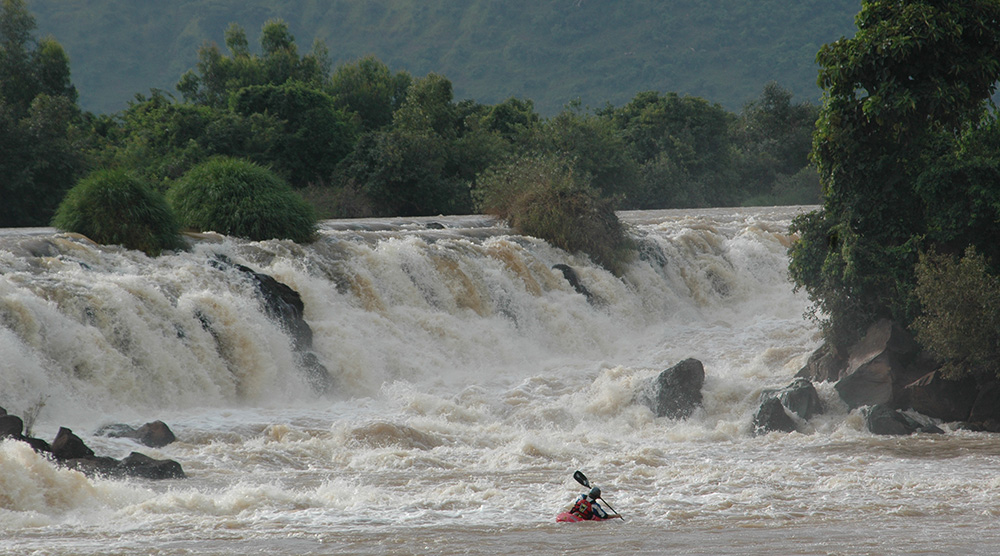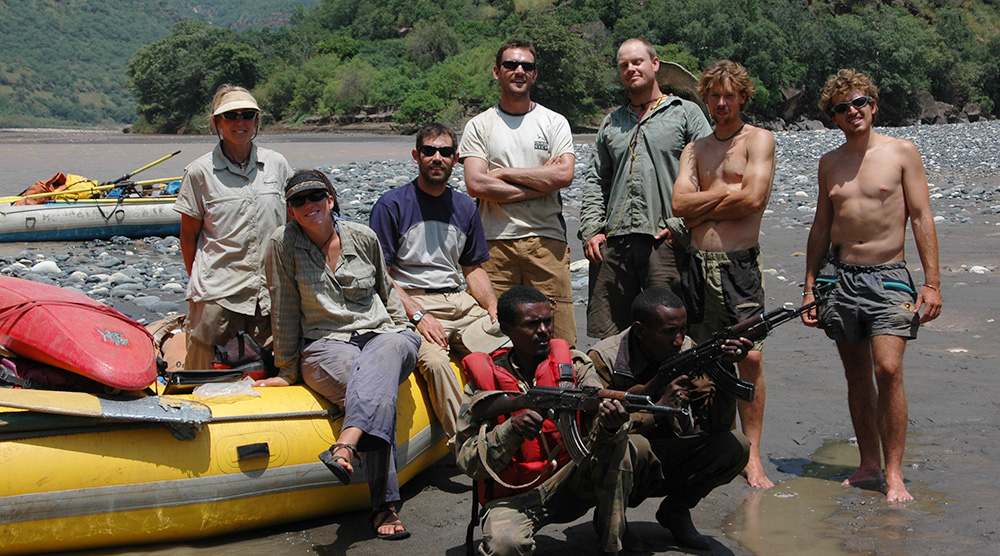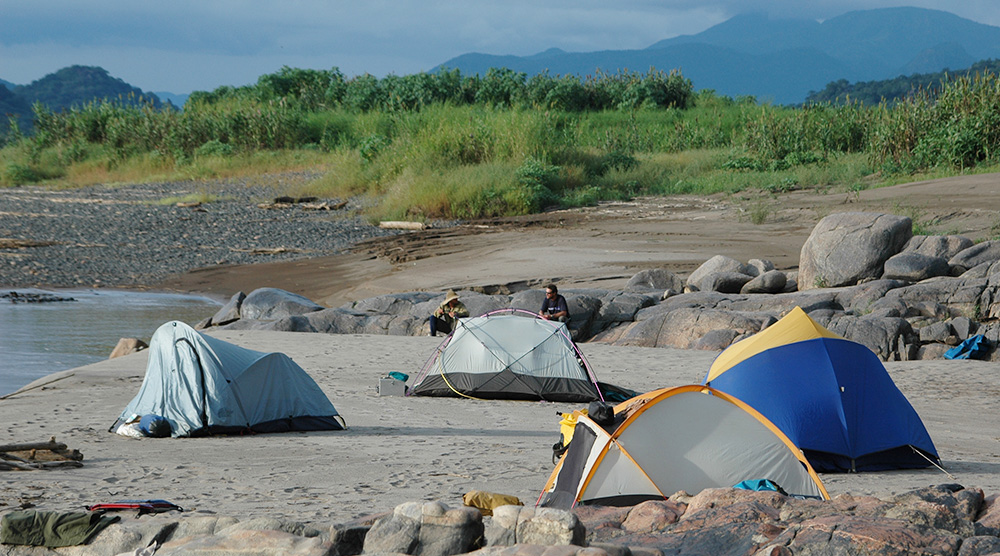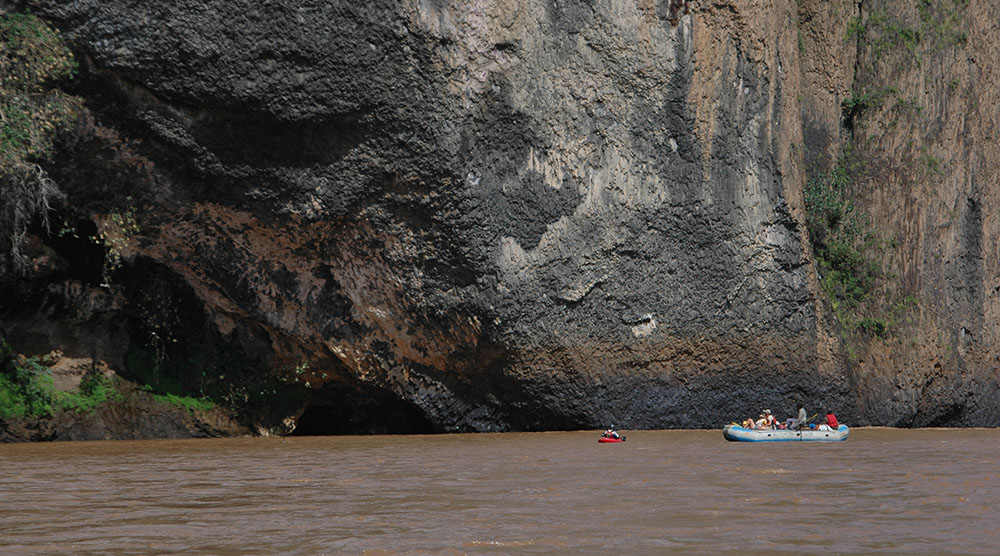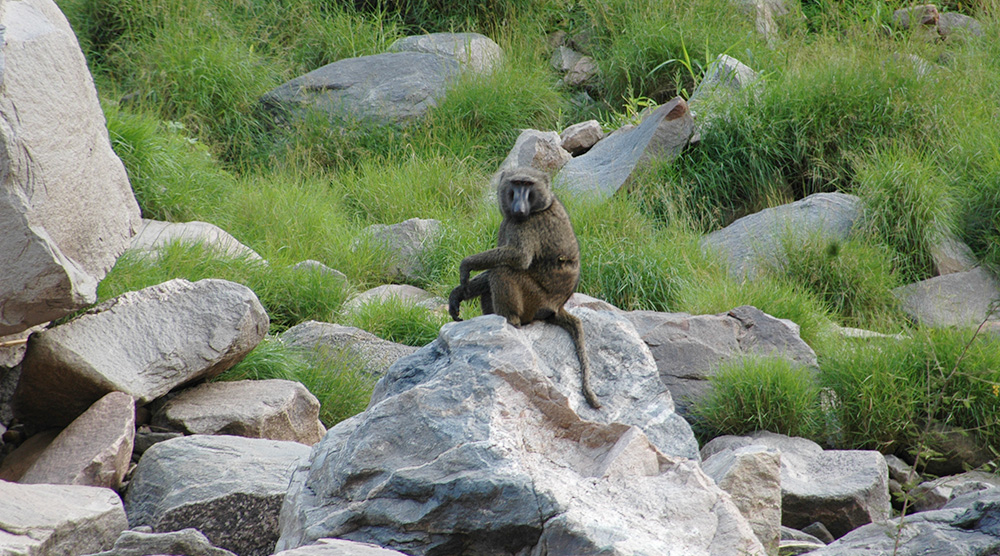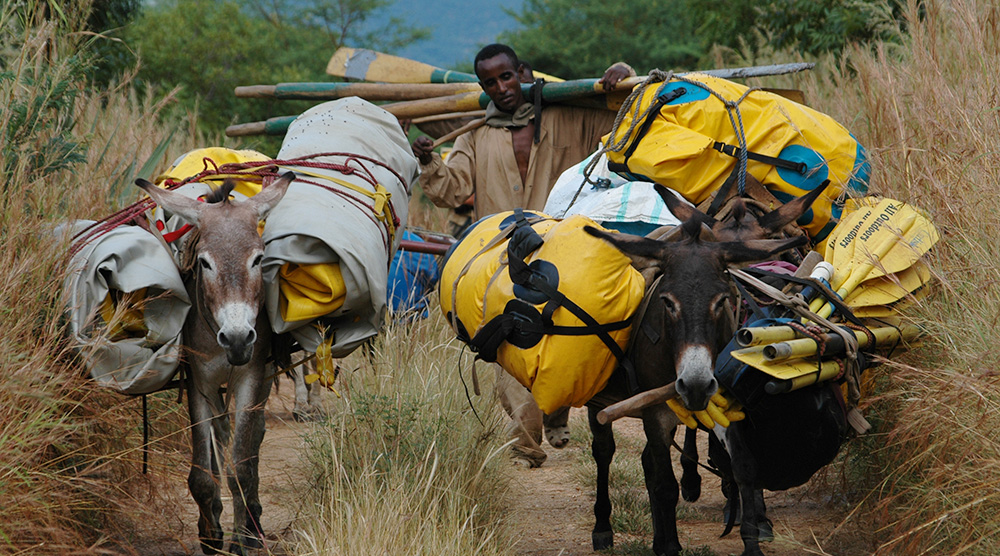Stories from Africa: Rafting the Nile River
Posted April 24, 2005 by Scott Armstrong - OwnerIn August of 2004, I joined an expedition attempting the first entirely man-powered descent of the Nile River from its headwaters in Ethiopia, to the coast of Egypt where it meets the Mediterranean Sea. The 3000 mile journey was broken up into two sections: a team of whitewater experts would raft the first 800 miles of the river and then, at the Sudanese border, two men would continue on the final 2,200 miles by sea kayak. The rafting team I was part of successfully completed our portion and returned home in November. This post describes a river trip that was much more than a “first descent,” or even just a really great rafting trip – it was powerful and moving in a way that none of the team members anticipated.
An Invitation You’d Be Crazy to Accept, But Can’t Refuse!
In the middle of August – the busiest time of the rafting season – my old friend Kelly Kalafatach casually walked into my office and asked if I’d like to be part of an expedition rafting 800 miles of the Nile River in Ethiopia. Kelly has been an international guide for over 20 years and has worked as a stunt double in movies such as “The River Wild.” That wasn’t Meryl Streep going over those waterfalls – it was Kelly. She had very few details about the trip and I had a very short time to decide if I wanted to be a part of it. I’d have to let her know in the next two days and leave for Ethiopia in two weeks! The prudent, sensible thing to do was tell Kelly I had too many work commitments and that two weeks wasn’t enough time to get ready. Plus, I knew nothing about Ethiopia, and didn’t want to commit to an expedition of this nature without having more information. So of course I proceeded to tell her with the utmost confidence that yes, I would love to be a part of the expedition.
I spent the next two weeks doing about 1/3 of the things I needed to do for All-Outdoors, getting only half the medical shots I needed, and making arrangements for a substantial amount of river gear to be shipped to Ethiopia.
Adventure Travelers Galore: The Team Arrives in Africa
On August 23rd I arrived in Addis Ababa, the capital of Ethiopia, and met the other members of the expedition. The organizers, Les and Mark, were from Canada and New Zealand. They had no whitewater experience but had assured us they were seasoned adventure travelers and had been planning the logistics and arranging for the proper government permits for four years. Their plan was to float the Nile River from its headwaters in Ethiopia, through Sudan, and finally out of Egypt and into the Mediterranean and be the first people to travel from the source of this great waterway to the sea by man-power alone. Rob and Ali were also part of the group. They are schoolteachers – and serious class V boaters – from Ireland who spend their summer vacations kayaking around the world. They’re great, extremely competent guys who were invaluable contributors to the trip. We also met Sarahlee, a college student and beginning guide who is traveling the world on a Watson Scholarship. Finally, there was a veteran guide named Anvesh, from India.
Reality Sets In
Upon arriving in Ethiopia the situation I had gotten myself into became clear. Although much thought had gone into the expedition there was a lot of work left to do; dealing with a situation on the ground is always different than drawing plans on paper. So, after wiring back home for more funds, changing our plane tickets to opened-ended returns, and shifting our outlook, the team committed to an experience that became more meaningful, exciting, and educational than any of us could have imagined. We thought we were just going on an extended river trip. In the end, what we got was in-depth exposure to a country and its people and we have been left with a lasting sense of amazement that those with so little in the way of possessions can be so full of life and care for others.
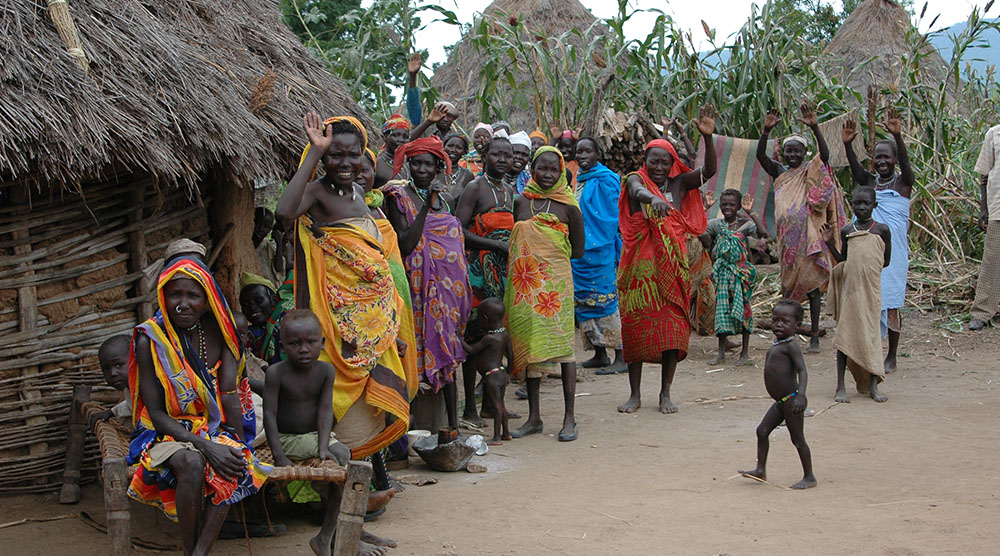
Logistics and Locals
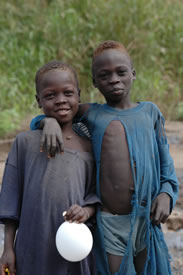
The initial plan was to start rafting within a week of our arrival. Instead, we spent three weeks ironing out details for the trip. Our tasks included arranging an off-river logistics person (an Ethiopian named Thomas, whom we met in front of our hotel), finding shuttle vehicles, digesting topographic maps, hiring guards, assembling rafting equipment, and purchasing food. Two 10-year-old boys I met on the street became invaluable helpers, running errands and doing odds and ends. To pay them for their help we bought them all their school supplies for the year.
A Last-Minute Addition From All-Outdoors
The preplanning took so long that Anvesh ran out of time and had to head back to India. So, I called Adam Walker (All-Outdoors Tuolumne River manager) and asked if he wanted to join us. I thought I had signed up last minute with little knowledge – Adam arrived within a week and the only information he had was the town and hotel in which to meet us!
On The River – With AK47’s!
We finally started rafting at the end of September. The eight of us and our two guards (who, by the way, couldn’t swim, but had 1950’s-era, AK47’s strapped over their shoulders) launched from where the Nile flows out of Lake Tana, Ethiopia’s largest lake. We started rafting on about 3,000 CFS (the average amount of water in a California river) in brown water that was filled with silt. It was to become darker, bigger, wider and deeper as we went; by the end of our journey the river would be flowing at around 80,000 CFS! This is a huge amount of water – bigger than the section of the Colorado that flows through the Grand Canyon.
The morning of our first camp we were introduced to what would become a regular occurrence. Unzipping my tent at 5 am, I found a group of locals staring at me. People had been waiting since the middle of the night to see who would come out of these strange, brightly-colored structures that had not been on their land the day before. Throughout the trip we were invited into villages and small mud huts to share food and drink with people who had never seen white people before. Little children would come up and try and rub the “white” off our skin, and sometimes ran crying to their parents when they saw us, these strange people in strange clothes.
The Grand Canyon of Africa
After a few days of meandering through a broad valley, the river narrowed down into a steeply walled gorge with sheer cliffs rising up 500 feet. At places the river narrowed so severely that one could jump from one side of the river to the other. One of the more challenging times was after we entered a gorge that was 40 miles long with intense whitewater. We could not stop and scout many blind bends and rapids, so Ali and Rob kayaked ahead and radioed directions back to the rafts. Many times we had to portage unrunnable rapids by lining our rafts through, or shoving them over the lip of the rapids and hoping they would come out at the bottom. Sometimes we had to rope our gear up the canyon walls and reenter the canyon further downstream. To compound the difficulties, upstream rains would cause the river to rise and fall up to 10 feet in a few hours. We camped as high up the canyon walls as possible to prevent us from having some very wet wake up calls during the night.
Baboons, Hippos, and Some Very Big Teeth
The midsection of the river trip was the most remote. We rarely ran into people but saw a lot of wildlife. We fished during the evening and had some wonderful catfish dinners to go with our bland expedition food. We floated by colonies of baboons, the leaders sitting on large boulders and staring as we passed by while the others took cover in the trees. Hippos floated in the calms with only their eyes showing. Every few bends in the river we would see a crocodile sunning itself on shore. Upon spotting us they would scramble to the water and follow the rafts. It was pretty unnerving to watch those two eyes and nose swimming towards us. It became even more disconcerting when they submerged a short distance from the raft, coming up to bite the oars or pull on the bowline and whip the raft from side to side. After a few of these incidents – during which we got a close-up view of the insides of their mouths – we carried a pile of rocks in the raft to use for target practice when the crocodiles got too close. During this stretch of river swimming was not an option and peeing off the side of the raft became standard procedure.
The World’s Longest Take-Out
As the trip drew to a close and we got closer to the Sudanese border, we began looking for a village called Bambudi, which is where we planned on taking out. Our Ethiopian friend Thomas had agreed to meet us there one month after we started the trip, and we were totally dependent on the rendezvous taking place because we had no other way to return to the capital city.
Upon arriving in Bambudi we had a few surprises. First of all, we were in Sudan, not Ethiopia! The village we were looking for was actually named Bamza and was ten miles upstream – we had floated right past it because we had gotten the name wrong. The mistake wasn’t a problem for Les and Mark, who were continuing on in sea kayaks through Sudan and into Egypt. The rest of us were extremely grateful when the Sudanese villagers helped us carry our gear to a tractor that hauled everything back upstream to Bamza, where we found another setback – the road was totally washed out and the closest town with road access was 150 miles away!
After three days of not knowing what to do and running solely on positive attitudes, we were relieved when Thomas came to the rescue – on a bicycle! He told us our take-out vehicles had gotten hopelessly stuck in the mud 100 miles away from us but that the local police chief had given him a larger, heavy-duty, 4-wheel drive, 40-foot truck to help us out. But, even that truck got stuck in the awful roads so Thomas had to finish the final 30 miles on foot and a borrowed bike. At this point, using vehicles was clearly out of the question, so after spending a day rounding up some donkeys we loaded all our gear on their backs and started the exhausting 30 mile hike towards the police chief’s truck. Once we found the truck we drove for another day packed in the bed with all our gear, and some locals (and their animals!) we picked up along the way. We drove up steep creek beds and across bridges that where nothing more than steel rails across ravines. After finding our original vehicles, we traveled for another two days on bumpy dirt roads back to the capital city.
What could have been a complete disaster ended up just fine because of the generosity and hard work of the people who helped us – this incident was just one of many that impressed upon us the incredible spirits of Ethiopians and the Sudanese.
Coming Home
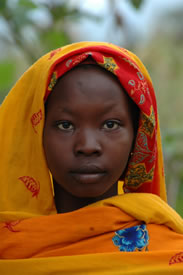 When I first got to Ethiopia I couldn’t have imagined the culture I would come to know, the beautiful scenery I would see, and the many challenges that would face me over the next two and a half months. The river trip itself was a great adventure, but what made the biggest impact on me were the Ethiopian people. In remote regions, people have little or no concept of the world outside of their village, but people who live in cities are very well educated and have a keen awareness of the rest of the world. It was very important to them that we understand Ethiopia isn’t just a county of drought, famine and desperation. Although people in the cities have a much different lifestyle from those living in remote areas, there is much they share. They are hard working people with kind hearts who love to open their homes and graciously share what little they have, which is why we were able to spend countless evenings in family homes sharing an evening meal, laughter, and a bond that transcends our different cultures.
When I first got to Ethiopia I couldn’t have imagined the culture I would come to know, the beautiful scenery I would see, and the many challenges that would face me over the next two and a half months. The river trip itself was a great adventure, but what made the biggest impact on me were the Ethiopian people. In remote regions, people have little or no concept of the world outside of their village, but people who live in cities are very well educated and have a keen awareness of the rest of the world. It was very important to them that we understand Ethiopia isn’t just a county of drought, famine and desperation. Although people in the cities have a much different lifestyle from those living in remote areas, there is much they share. They are hard working people with kind hearts who love to open their homes and graciously share what little they have, which is why we were able to spend countless evenings in family homes sharing an evening meal, laughter, and a bond that transcends our different cultures.
Postscript
When we left the leaders Mark and Les at the Sudanese border, their intention was to continue the 3000-mile journey they began at the headwaters of the Nile and finish at the Mediterranean Sea. They are paddling through remote areas so we haven’t gotten many reports on their progress but understand the expedition is going well.
